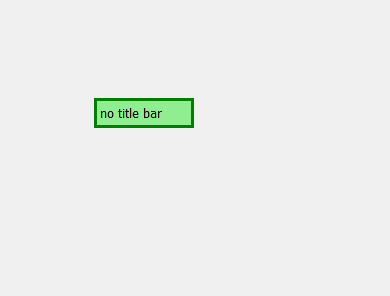Cuando diseñamos la aplicación GUI (interfaz gráfica de usuario) usando PyQt5, existe la ventana. Una ventana es una porción (generalmente) rectangular de la pantalla en un monitor de computadora que presenta su contenido (por ejemplo, el contenido de un directorio, un archivo de texto o una imagen) aparentemente independientemente del resto de la pantalla. Windows es uno de los elementos que componen una interfaz gráfica de usuario (GUI).
En una ventana podemos ver que existe una barra de título que comprende el icono y el título en el tamaño izquierdo y en el lado derecho existe el botón de control.
En este artículo veremos cómo podemos ocultar la barra de título. Para hacerlo, usaremos setWindowFlag()el método y el pase que pertenece al archivo QWidget class.
Sintaxis: setWindowFlag(Qt.FramelessWindowHint)
Argumento: toma el tipo de ventana como argumento.
Acción realizada : Elimina la barra de título.
Código:
# importing the required libraries
from PyQt5.QtWidgets import *
from PyQt5.QtGui import *
from PyQt5.QtCore import Qt
import sys
class Window(QMainWindow):
def __init__(self):
super().__init__()
# this will hide the title bar
self.setWindowFlag(Qt.FramelessWindowHint)
# set the title
self.setWindowTitle("no title")
# setting the geometry of window
self.setGeometry(100, 100, 400, 300)
# creating a label widget
# by default label will display at top left corner
self.label_1 = QLabel('no title bar', self)
# moving position
self.label_1.move(100, 100)
# setting up border and background color
self.label_1.setStyleSheet("background-color: lightgreen;
border: 3px solid green")
# show all the widgets
self.show()
# create pyqt5 app
App = QApplication(sys.argv)
# create the instance of our Window
window = Window()
# start the app
sys.exit(App.exec())
Producción :
Publicación traducida automáticamente
Artículo escrito por rakshitarora y traducido por Barcelona Geeks. The original can be accessed here. Licence: CCBY-SA